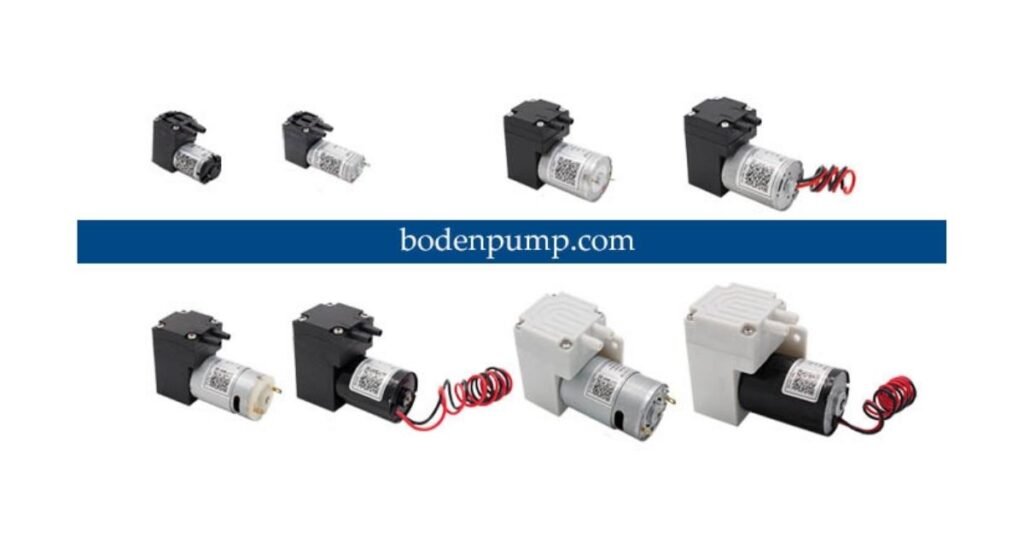
The realm of miniature pumps has always been a landscape of ongoing innovation and complexity. One such innovation that has captured the industry’s attention is the eccentric diaphragm pump. But what is it exactly, and how does it differ from conventional diaphragm pumps?
Simply put, an eccentric diaphragm pump leverages an eccentric mechanism to move the diaphragm, resulting in more efficient flow and pressure management.
Stay tuned as we take you through the world of eccentric diaphragm pumps, one of the exciting pump technologies I deal with regularly as the product manager at BODENFLO. Stick around as I dissect this unique technology, its components, and its revolutionary applications.
How Does an Eccentric Diaphragm Pump Work?
Machine Principle
Diving deeper into the mechanics, the eccentric diaphragm pump utilizes a carefully designed eccentric mechanism to manipulate the diaphragm’s movements. In simpler terms, the mechanism’s axis is not aligned with the center, causing it to be ‘eccentric.’ This seemingly minor tweak allows for a dramatic difference in the diaphragm’s oscillation pattern, resulting in a more optimized pumping action.

Central Feature: Eccentric Rotor
The central feature here is the eccentric rotor. When this rotor rotates, it pushes the diaphragm back and forth in a non-linear fashion. This asymmetrical movement can be finely tuned, allowing for precise control over the pump’s output, be it flow rate or pressure. If you’re a technical enthusiast, you’d be interested to know that the design allows for the modulation of certain parameters like amplitude and frequency of oscillation, which can be critical for specialized applications. Several research articles have detailed the nuances of this unique operation model, affirming its efficiency advantages over traditional diaphragm pumps.
Diaphragm material
Another remarkable feature is the diaphragm material itself. Made from high-quality elastomers or thermoplastics, the diaphragm can withstand a variety of media types, including corrosive and abrasive substances. This material quality, coupled with the unique pumping action, ensures a longer life span for the pump and reduced maintenance overheads.
This is not just a minor upgrade over conventional diaphragm pumps but a significant leap in technology that promises not only to enhance performance but also to redefine efficiency and versatility in fluid transfer applications.
Why Opt for Eccentric Over Traditional Diaphragm Pumps?
As someone deeply entrenched in the micropump sector, I often encounter the query: why opt for an eccentric diaphragm pump over traditional diaphragm pump configurations? This is a pertinent question warranting a comprehensive answer, backed by both technical considerations and market dynamics.
- Firstly, let’s discuss efficiency parameters. Eccentric diaphragm pumps offer superior volumetric efficiency due to minimized dead space within the pumping chamber. This translates to optimized fluidic throughput—a key performance indicator within industrial applications.
- Operational adaptability is another differentiator. Eccentric diaphragm pumps exhibit remarkable versatility in accommodating a wide range of operational pressures and flow rates, attributable to their asymmetrical design configurations. This level of adaptability is a vital criterion in numerous specialized applications, as our portfolio at BODENFLO attests to.
- In terms of mechanical longevity, eccentric models distribute stress more uniformly across the diaphragm, resulting in diminished wear and tear over prolonged operational cycles.
- Let’s pivot to maintenance considerations. Eccentric diaphragm pumps inherently require fewer service interventions, attributable to a reduced part count in comparison to their traditional counterparts. This not only lowers maintenance overhead but also significantly mitigates the risk of operational downtime—a salient factor in total cost of ownership (TCO) evaluations.
To encapsulate, the eccentric diaphragm pump design confers quantifiable advantages in the realms of efficiency, operational flexibility, mechanical robustness, and maintenance ease. Therefore, it constitutes a prudent choice for enterprises aiming for optimized operational metrics.
What Are the Key Components of an Eccentric Diaphragm Pump?
Understanding the architecture of an eccentric diaphragm pump is paramount to fully appreciating its advantages and operational nuances. At BODENFLO, we believe in transparency and knowledge sharing. Therefore, let me guide you through the essential components of this innovative pump design.

The heart of the pump is the diaphragm itself. It’s an elastomeric, flexible membrane that reciprocates to create suction and discharge strokes. Advanced materials like EPDM or PTFE are often employed for improved chemical resistance and durability. Material choices are crucial for targeted application compatibility.
The eccentric cam, the namesake of this pump type, is an asymmetrical rotor that imparts the motion to the diaphragm. Its design ensures the diaphragm stretches uniformly, allowing for a more consistent flow rate and reducing wear and tear. Through continuous R&D, we’ve optimized this component for maximum efficiency.
Valves are the next critical piece of the puzzle. These are typically flap or ball valves strategically placed to regulate fluid direction. When the diaphragm contracts, these valves open or close in sync, ensuring a unidirectional flow. I can’t stress enough how valve design influences the overall pump efficiency.
Finally, the pump housing encloses all these components, providing the structural integrity required for safe and robust operation. The housing materials must be compatible with the fluid being pumped, resistant to wear and corrosion, and designed for ease of maintenance.
So, there you have it—the key components that come together in a finely tuned engineering marvel that is the eccentric miniature diaphragm pump. Each part serves a unique purpose, and it’s their synergy that sets this pump type apart from traditional diaphragm pumps.
Where Can You Use Eccentric Diaphragm Pumps?
The applications for eccentric diaphragm pumps are diverse and span across various industries. Due to their unique set of characteristics, including high efficiency and the ability to handle a range of fluids, these pumps have carved out a niche in both specialized and broad-range applications.
Medical Devices
In the medical field, these pumps are integral in negative pressure wound therapy (NPWT) devices. The precise control they offer ensures a stable environment for wound healing.

Testing Equipment
When it comes to leak detection, the accuracy of eccentric diaphragm pumps is unparalleled. Leak testing instruments often require stable and controlled flow, which these pumps can deliver consistently.
Environmental Monitoring
VOC online analyzers in environmental monitoring benefit from the ability of these pumps to handle volatile organic compounds without contamination or chemical reaction, thus ensuring accurate readings.
Chemical Vacuum Systems
In the chemical industry, these pumps are commonly used in vacuum systems that require the handling of corrosive or volatile substances. Their robust design can withstand harsh chemical environments.

Laboratory Instruments
The preciseness and controllability of eccentric diaphragm pumps make them ideal for analytical instruments in laboratories where even a minor fluctuation can result in skewed results.
Gas Sampling
In the field of gas sampling, these pumps offer the advantages of low pulsation and the ability to handle a mixture of gases, making them a preferred choice for sophisticated sampling systems.

How Do Miniature Eccentric Diaphragm Pumps Compare to Other Miniature Pump Types: A Detailed Analysis
In my role as a product manager at BODENFLO, specializing in pumps, a question I often encounter is how different types of miniature pumps compare, particularly eccentric diaphragm pumps. Let’s delve into the contrasting aspects: principles of operation, performance parameters, application ranges, cost factors, and material considerations.

Principle of Operation
Eccentric Miniature Diaphragm Pumps vs. Peristaltic Pumps:
Eccentric diaphragm pumps operate by utilizing an eccentric movement to displace the diaphragm, whereas peristaltic pumps use rotating rollers to squeeze a tube. The difference in the operational principle leads to distinctions in flow rate accuracy and fluid compatibility.
Eccentric Miniature Diaphragm Pumps vs. Gear Pumps:
Gear pumps rely on the meshing and unmeshing of gears to move fluid. In contrast, eccentric diaphragm pumps use mechanical deformation. This makes diaphragm pumps less susceptible to clogging when handling particles but also less suitable for high-viscosity fluids.
Eccentric Miniature Diaphragm Pumps vs. Electromagnetic Pumps:
Electromagnetic pumps utilize electromagnetic fields to move conductive fluids, limiting their range of compatible fluids. Eccentric diaphragm pumps, however, are more versatile in the types of fluids they can handle.
Performance Parameters
Flow Rate and Accuracy:
Micro diaphragm pumps for pressure & vacuum & liquid generally offer a balanced profile in terms of flow rate and accuracy, though they are not optimal for high-viscosity fluids due to potential valve clogging, a limitation not shared by gear pumps.
Pressure and Vacuum Capabilities:
Compared to peristaltic and electromagnetic pumps, eccentric diaphragm pumps often deliver higher pressure and vacuum performance.
Application Ranges
Eccentric Diaphragm Pumps in Medical and Laboratory Settings:
Due to their precise flow rates, they are widely used in applications that require metering and dosing but are not ideal for highly viscous fluids.
Gear Pumps in the Oil and Gas Industry:
Their ability to handle high-viscosity fluids makes them a go-to choice in industries like oil and gas.
Electromagnetic Pumps in Specialized Industrial Processes:
These pumps are typically used in specialized applications that require the movement of conductive fluids.
Cost Factors
Eccentric diaphragm pumps usually have a moderate initial cost but lower long-term operational costs due to fewer wear and tear parts, unlike gear pumps that might require frequent maintenance.
Material Considerations
Material compatibility is essential, especially when corrosive or abrasive fluids are involved. Eccentric diaphragm pumps generally offer a range of material options for the diaphragm and other wetted parts, providing a level of customization that is not as readily available in other pump types.
How to Choose the Right Eccentric Diaphragm Pump?
Selecting the right eccentric diaphragm pump for your application isn’t merely a matter of brand or cost; there are multiple factors to consider for optimal performance and longevity. Let’s break down the key aspects you should keep in mind.
Fluid Compatibility
First and foremost, make sure the pump is chemically compatible with the fluids you intend to move. This might involve scrutinizing the materials used in the diaphragm and other wetted components.
Performance Parameters
It’s crucial to evaluate your requirements in terms of flow rate, pressure, and vacuum. The pump you choose should meet or exceed these specifications.
Material Quality
Material choice will affect the pump’s durability, especially when dealing with corrosive or abrasive fluids. Look for pumps with materials that can withstand your specific application conditions.
Operational Efficiency
Consider the efficiency of the pump in terms of power consumption, as this will directly impact operational costs. Certain pumps may be more energy-efficient but might compromise on other performance parameters.
Maintenance Requirements
Some pumps are easier to maintain than others. A pump with fewer moving parts will generally require less maintenance. However, don’t ignore factors like ease of disassembly and availability of replacement parts.
Certification and Compliance
Lastly, ensure that the pump has the necessary certifications for your industry, whether it’s FDA approval for food and drug applications or other relevant safety and quality standards.
By giving due consideration to these factors, you can make an informed decision that aligns with both your technical requirements and budget constraints.
When selecting a miniature pump, it’s crucial to consider the specific needs of your application. Eccentric diaphragm pumps offer a well-rounded performance profile but have limitations in handling high-viscosity fluids due to potential valve clogging. Depending on the parameters, applications, costs, and material requirements, one type of pump may be more suitable than another. Therefore, an in-depth understanding of these contrasting aspects is essential for making an informed decision.
Elevate Your Operations with BODENFLO Eccentric Diaphragm Pumps

If you’re in the market for reliable, high-performing eccentric diaphragm pumps, look no further than BODENFLO. As a leading manufacturer in the micro pump industry, we offer highly customizable solutions tailored to meet your specific needs. Whether you’re in medical devices, leak testing, or environmental monitoring, our pumps deliver exceptional accuracy and efficiency, setting new standards in your field. Experience unparalleled performance and elevate your operational excellence today with BODENFLO. Contact us now for more information.
Conclusion
The eccentric diaphragm pump is a revolutionary advancement in the miniature pump industry. With its unique mechanism, superior efficiency, and versatile applications, it stands as a compelling option for those looking to optimize their systems.



